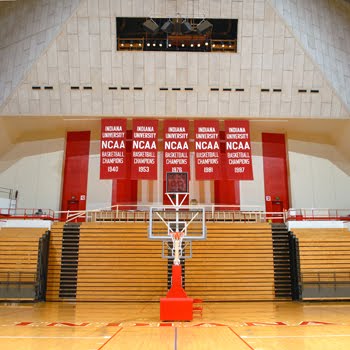Last week I received the proposed agenda for Wednesday's City of Hollywood city commission meeting and noticed that they will be voting on a resolution regarding the Florida Hometown Democracy amendment to the FL constitution.
That is to say, Item #8 on Wednesday afternoon's agenda,
http://www.hollywoodfl.org/docdepotcache/00000/673/Agen%2010-03-07.pdf
This is, no doubt, a vote urged upon the city's powers-that-be by the usual quasi-govt. suspect groups that always evade scrutiny in local media, esp TV, like the Broward League of Cities, currently headed by Hallandale Beach's own Evita, Mayor Joy Cooper, to oppose what yours truly believes is a much-needed if somewhat imperfect amendment to the Florida state constitution.
Why do I support the amendment?
Because experience has taught me that local governments in South Florida do such a piss-poor of delivering even the most basic of services, why should I just trust them -for perpetuity- on matters that the area will be forced to live with forever?
It's a valuable tool which, if used properly, can act as a veto on local politicians' neverending myriad bad decisions/strategy on planning and development, among other things.
No longer would citizens be permanently hamstrung, on the hook and in the hole for decisions to green-light projects for developers under the pretense of gaining jobs or raising local taxes, much less, campaign contribution$.
And then, perhaps most galling of all, as happened here in Hallandale Beach a few months ago, having the audacity to pat themselves on their back and asking for and voting on a 300% salary increase.
(Can I help it if 99% of the city can't quite picture the HB city commissioners as "corporate executives," which I believe is the phrase that HB Vice Mayor Bill Julian used to describe himself and his colleagues a few months age.)
Believe me when I tell you, even though I'm a lifelong Democrat, of the DLC stripe, I saw a lot of crazy things that defied logic and reason on a regular basis during the 15 years I lived in overwhelmingly Democratic Arlington County, VA, the smallest county in the U/S., just west of Washington, D.C.
It's a place that had a very high quality of life, but you sometimes paid a heavy price for it in unexpected and unintended ways on the flip side.
Chief among these was a county power structure and machine that often resembled the worst of Soviet central planning, where county pols and employees often treated Arlington County citizens like lab rats in an maze experiment, like something they needed to do before they gained their PhD. in Political science at in Madison at U-W, the University of Wisconsin.
Unable to keep residents of a nearby homeless shelter from camping out on chairs and small couches seats in the halls and lobbies of the county building HQ during the winter, the county decided to simply remove them completely, rather than have a heart-to-heart talk with the small number of people taking advantage of something intended for people having business in the building during the business day.
Like Arlington County taxpayers.
County commissioners were so politically tone-deaf that even after 9/11 -and justly praising the Arlington Fire Dept.'s performance at the Pentagon- they felt so perfectly immune to any and all public and media criticism, that when the Arlington citizenry wanted to have the recitation of the Pledge of Allegiance before public meetings, they said nyet, and then went on to congratulate themselves, as if they were characters in a an Arthur Miller allegory, casting themselves as the true patriots, don't you know. It was perfectly preposterous and galling.
But even the folks in Arlington County would blanche at the sort of self-congratulation that regularly takes place routinely in local government, witness almost any Hollywood or Hallandale Beach city commission meeting, as being over the top.
Consider for instance the recent case of HB Vice Mayor Bill Julian.
At the last HB city commission meeting, he went off the rail on a self-congratulatory rant about his participation with a local group that picked up litter on the (perfectly and consistently
dirty) beach in Hallandale.
It was all I could do to not walk up to the microphone during the public comment part of the meeting and read him the Riot Act, dissecting his comments by bring up some very Inconvenient Truths:
1. Never mind that the small beach has looming condo towers that block out the sun because the city never bothered to do a 'shadow study.'
2. The beach where police never make an appearance, even on boisterous three-day weekends
3. The beach where the supplies in the bathrooms are almost always out by 4 p.m. on Friday afternoon, never to be refilled 'till the following week.
4. The beach where garbage cans don't have lids and where the contracted lifeguards constantly complain about having to clean up garbage debris that pops up out of the bins on even slightly breezy days.
That is, when the guards themselves aren't being saved by Hollywood's lifeguards, as has been told to me by any number of Hollywood guards because the HB-contracted guards are "out of shape," and,
5. Don't have access to jet skis, which is especially important during times of rip tides, as was the case for the better part of the beginning of this year.]
No, I'd rather hear him justify his being able to leave his political signs and their support stands along Gulfstream Park & US-1 for months after March's election, while HB's code compliance office acts like they either don't see them, or, can't quite recall whose signs were there for weeks on end.
Not laissez-faire government of the worst sort, just lazy.
Me, I'm more interested in seeing some local pols convicted, but what can I say, I'm old-fashioned that way. Just chalk it up to the political romantic in me.
That, plus, within the past two weeks, I once again watched Washington Merry-Go Round again for the first time in ten years.http://www.imdb.com/title/tt0023673/
It got me focused all over again to do a much better job of explaining the rationale of my blog to new comers and shining a light on the endless problems in the area that local pols ignore, mismanage and look the other way on, even while telling me during breaks
in city commission meetings that they've read what I've said.
Yet, months later, the problems, even the easily-solved ones, remain for everyone to
see.
As to the amendment itself, prior to this great column by Carl Hiaasen on Sunday, the Miami Herald had only written five stories about it over the past 12 months, and much of those was only tangentially interested in discussing the ramifications.
http://www.hollywoodfl.org/docdepotcache/00000/673/R-2007-320.PDF
City of Hollywood REGULAR CITY COMMISSION MEETING October 3, 2007
This item will be discussed and voted upon after 1:30 p.m.LEGISLATIVE AFFAIRS8. R-2007-320 - Resolution - A Resolution Of The City Commission Of The City Of Hollywood, Florida, Opposing Florida Hometown Democracy’s Proposed Amendment To The Florida Constitution That Would Force Voters To Decide All Changes To A City Or County Comprehensive Plan; Urging Municipalities Throughout Broward County And The State Of Florida, As Well As Florida Electors, To Oppose The Florida Hometown Democracy’s Proposed Amendment To The Florida Constitution; And Providing For An Effective Date.
____________________________________
"Who's Lesley Blackner?" Published 3/1/2007 in Florida Trend Cover Story - Growth Planning, Who's Lesley Blackner? Meet the woman whose ideas are hated by every business group in Florida. by Mike Vogel http://www.floridatrend.com/article.asp?aID=53568373.4436903.599885.1313125.1614023.979&aID2=46136
http://www.palmbeachpost.com/opinion/content/opinion/epaper/2007/09/27/w17a_edletters_0927.html Palm Beach Post
Letter to the Editor: 'Hometown Democracy' best in growth decisions
Time and time again, we find ourselves in a fight with an elected official over land development. Burt Aaronson continues to stand by his decisions as those of the people he represents ("Aaronson defends farmland roadway," Sept. 20).
Isn't this the same old cry when an elected official wants something done? How can we check? There are no votes to count. There is nothing official to verify that the voters want development or growth. The answer, however, lies in the Florida Hometown Democracy Act, for which many Floridians are collecting petitions, to change the way things are done. Hometown Democracy is a citizen campaign to change the state constitution in the 2008 election. The idea is for local voters, not elected officials, to make major growth decisions.
Of course, developers and a lot of politicians don't want this law passed because it would take the power away from them as decision-makers. But it gives the power to the people, where it should be. The grass-roots campaign needs about 120,000 more petitions signed to put it on the ballot for the 2008 election, and time is running out. If politicians really wanted to make decisions based on their constituents' benefit and wants, then they should go to http://www.floridahometowndemocracy.com/ and sign a petition. We all need to. I wonder how many commissioners, if any, have done that?
RON GOFORTH, West Palm Beach
__________________________
Crist opposes growth limits by Jason Garcia, Orlando Sentinel Staff Writer September 25, 2007 http://www.sun-sentinel.com/orl-crist25_107sep25,0,3647880.story
__________________________________________________
Treasure Coast growth questions may split 2008 vote by Hillary Copsey September 24, 2007 http://www.tcpalm.com/news/2007/sep/24/growth-questions-may-split-08-vot/
____________________________________________________________
2 are leading drive to rein in Florida development by Kevin Spear, Orlando Sentinel Staff Writer September 24, 2007 http://www.orlandosentinel.com/orl-hometown2407sep24,0,4123900.story
__________________________________________________________
http://www.miamiherald.com/news/columnists/carl_hiaasen/story/253942.html
Miami Herald
Land-use initiative facing sneaky tactics
by Carl Hiaasen
September 30, 2007
You can be sure you're on the right side of an issue if John Thrasher is on the other.
The former Florida House speaker and big-shot lawyer-lobbyist has sent out a mass-mailing to scare voters into removing their signatures from a statewide petition in favor of the ''Florida Hometown Democracy'' amendment.
The Hometown Democracy initiative would let citizens vote to approve or reject major changes to the comprehensive land-use plans in their counties or cities. For the first time, Floridians would have some direct control over how their communities grow.
Thrasher's deceptive and slimy letter is proof of the panic that has set in among those who've made a fortune raping the state and are afraid of losing their sweet ride.
The lobbyist ominously warns that, if the Hometown Democracy amendment passes, ''special interests'' will triumph and ''Big Developers'' will wreck Florida's ``scenic beauty.''
Like it's not happening now?
Special interests already manipulate many county and city commissions -- not to mention the Legislature -- while Florida's green space continues to disappear under bulldozers at the rate of hundreds of acres per day.
What Thrasher neglects to reveal in his fright mailing is that big developers and landholders are the ones most frantically opposed to the Hometown Democracy movement, and that he himself represents some of the biggest, including the St. Joe Co., which is currently selling off the Panhandle.
He says that allowing the voters to decide whether they want a new megamall or condo tower down the street could stifle growth and cause taxes to go up -- another cynical fiction designed to frighten middle-class workers and the elderly.
What really causes taxes to soar is the need for increased services due to overdevelopment and overcrowding. Bad planning means that the public ends up paying dearly and repeatedly for more roads, fire stations, police patrols, water-treatment plants and schools.
Lots of folks in Miami-Dade, Broward and Palm Beach counties will tell you that runaway growth has done nothing but push up their tax bills and diminish the quality of their family's lives.
All over the state, Floridians are disgusted by the failure of their elected officials to do restrained, responsible planning. That's why the Hometown Democracy petition has momentum.
While it might not be the perfect answer to derailing the engine of manic greed that's ruining so many lovely places, many residents are so heartsick and frustrated that they would welcome a dramatic change.
According to the website, www.hometowndemocracycom, petition supporters have collected about 331,000 verified signatures of the 611,009 needed to place the amendment on the November 2008 ballot.
Thousands more signatures are awaiting validation. The deadline for signing is Feb. 1, only four months away, which has lent urgency to the opposition's propaganda blitz.
Nothing is so horrifying to some developers and corporate interests as the prospect of having to deal directly with citizens when trying to get a building project passed. It's much easier to woo politicians, whose loyalties often can be purchased with a hefty campaign contribution or (as in recent cases in Palm Beach County) outright bribes.
That's the way things have always worked in Florida, which explains the plague of ugly sprawl. The Hometown Democracy petition would throw a wrench in that whole cozy, corruptible process.
Predictably, opponents grandiosely calling themselves Floridians for Smarter Growth have cooked up a rival constitutional amendment that would require 10 percent of voters in a city or county to sign a petition, before any land-use referendum takes place.
The petitions could be signed only at the office of a municipal clerk or elections supervisor, an inconvenience that virtually guarantees a fatally low turnout.
Obviously, the forces behind Floridians for Smarter Growth aren't interested in participatory democracy. They want the public to shut up and let the politicians do their thing.
According to The Sun-Sentinel, the group raised $841,000 between April and August. Major donors included the National Association of Home Builders, the Florida Chamber of Commerce and U.S. Sugar.
It's a motley roster of special interests whose motives are anything but pure.
The Hometown Democracy movement undoubtedly was the prime target when pro-development legislators passed a law allowing voters to revoke their signatures from amendment petitions.
That opened the door for John Thrasher's specious letter pretending to denounce the very developers for whom he's shilling. In urging citizens to abandon the Hometown Democracy campaign, he blames ''slick lawyers'' for tricking them into putting their names on the petition.
Thrasher himself is one of the slickest lawyers in Tallahassee, and it is he who has stooped to shameless trickery.
His scare letter comes with a postage-paid envelope. Mail it back with the two-word reply of your choice.
_____________________________
Miami Herald
Strippers swirl around growth-plan push
By Marc Caputo, mcaputo@MiamiHerald.com
September 19, 2007
Warning! "Slick lawyers" and "special interests" are tricking citizens into signing petitions for a development-limiting amendment that actually helps "big developers." The message comes courtesy of lawyer John Thrasher, a lobbyist for one of the state's biggest developers, St. Joe Co. and Associated Industries of Florida, among others. He's urging people in his letter sent throughout the state to take advantage of a new business-backed law allowing voters to revoke their signature on a petition to get a constitutional amendment before voters.
In this case, the proposed "Florida Hometown Democracy" amendment would give voters the right to veto or approve any growth-plan change made in their area. And that has developers, the business lobby and local governments worried.
For starters, the amendment could delay some developments by months, and subject even minor projects, such as the siting of a gas station, to a citizen vote. And that could tie the fate of the smallest, least controversial projects to larger developments.
The Florida Chamber of Commerce is hitting back with its own group, Floridians for Smarter Growth, and an amendment that seeks to all but cancel the Hometown plan.
The rival petitions, Thrasher's letter, the Wednesday debate here and a Tampa Bay debate last week -- in which apparent strippers showed up with misspelled placards in favor of a Hometown Democracy supporter who owns a strip club -- show that this will be one of the more spirited campaigns.Thrasher said in a Wednesday debate at Tallahassee's Tiger Bay Club that the ramifications of the Sierra Club-backed amendment are "very terrifying:" higher taxes, more politics in the planning process and less accountability from local government commissioners abrogating their duties via plebiscite.
His rival, Ross Burnaman with Florida Hometown Democracy, said Thrasher is misleading people during the forum and through his recent letter. Burnaman said this amendment would just give citizens a final say over how their community is growing, and he pointed out that bid developers oppose this plan.Burnaman said his group is only 100,000 signatures shy of the 611,000 needed by Feb. 1 to get the measure before voters in November 2008.
Thrasher, a former Florida House Speaker who lobbies for Associated Industries of Florida as well, hopes to cancel some of those petitions through his letter, which says people have been "tricked" into signing the petition by "mercenary" signature gatherers.
Thrasher said he's not affiliated with the chamber's group, which is using paid signature gatherers.If the Hometown amendment makes the ballot and passes, citizens could vote on growth changes once a year, twice yearly or even more often.
Said Thrasher: "Democracy's not cheap."
Copyright (c) 2007 The Miami Herald
___________________________
Miami Herald
Campaign flier mystery solved
By CARLI TEPROFF AND TANIA VALDEMORO, cteproff@MiamiHerald.com
April 29, 2007
NORTH MIAMI BEACH
North Miami Beach resident Bill Borkan has contributed tens of thousands of dollars to a South Miami-Dade County-based electioneering communications organization, or ECO, that has put out at least five fliers attacking two incumbents in Tuesday's elections. The glossy, color fliers have been circulating around the city charging Kenneth De Fillipo and David Templer with voting for higher taxes and an increased crime rate, and became an issue as residents speculated who was behind them.
Borkan's role was not confirmed until earlier this week, after confusion arose over the name of the entity that financed the ECO's work.
The confusion arose when the ECO's contribution report listed a total of $53,500 in contributions from Florida Hometown Democracy Inc.
The problem: the address listed for Florida Hometown Democracy on the report doesn't match that of a New Smyrna Beach political action committee registered under that name with the state. Instead, the address listed was 12000 Biscayne Blvd., Suite 502 -- the same as several businesses owned by Borkan.Leslie Blackner, the registered agent for Florida Hometown Democracy in New Smyrna Beach, was angry when first asked if her group was connected to the donation. Her group is leading a statewide petition drive to get an amendment on the 2008 ballot requiring voter approval for zoning variances.
"I have no idea why he would use our name for this, but I can assure you I have no idea what this about," Blackner said.
Borkan and Keith Donner, a political consultant who is the treasurer and chairman of the South Miami-Dade ECO, would not comment about the confusion for several days, but on Wednesday Donner said it was an "unfortunate oversight."
As it turns out, Borkan was behind the creation of a corporation by the same name in Delaware in February.
On Thursday, Borkan downplayed the incident and said he was sorry for the confusion over the name.
"Everyone uses corporations" to donate money to ECOs, he said.
Borkan said that as soon as he realized that it was the same name, he sent a letter to the Florida Elections Department agreeing to retire the name.
The pamphlets bear pictures of De Fillipo and Templer, with the general message that taxes are too high and crime rates have skyrocketed -- and that the two incumbents are to blame.
De Fillipo and Templer "are more concerned about helping their Big Developer friend than residents," one mailer states.
"Everything is factual," Borkan said of the fliers.
Templer says he is outraged by what he calls "the lies being spread in the pamphlets."
"The fliers are a pack of lies resulting from someone who has a personal agenda against me," he said. "[Borkan] must believe that people are deaf, dumb, blind and probably dead not to understand what's going on."
De Fillipo was livid, saying the ads manipulate the truth.
"The educated voter will see right through it and throw it in the garbage," he said.
Borkan heads the North Miami Beach Citizens Coalition, which last year mounted a petition drive to place an amendment on the ballot requiring voter approval of zoning variances.
That petition fell short by just 11 signatures -- after 1,680 signatures were disqualified by the county elections department.
The coalition subsequently sued the county and city, claiming the signatures should not have been disqualified. Months later the city and the coalition reached an agreement, and Borkan agreed to drop the suit.
Borkan said that although he is not running for office, by contributing to the ECO he can help challengers put up a fight against incumbents who he said have collected money from developers.
"I am doing this to level the playing field," he said.Electioneering communications organizations, commonly known as ECOs, allow individuals and groups to feed money for paid political advertisements.
Unlike contributions to candidates or campaigns, which may not exceed $500 per person or company, there is no limit to how much individuals or companies can donate to ECOs.
There are some restrictions on ECOs, mainly that their ads must be "issue-based."The general rule is they can't use the magic words 'vote for' or 'vote against,' " explained Mark Herron, an election lawyer based in Tallahassee.
Copyright (c) 2007 The Miami Herald
___________________________
Miami Herald
Activist: Voters can rein in growth
By TANIA VALDEMORO tvaldemoro@MiamiHerald.com
January 17, 2007
DEVELOPMENT
It's the residents -- not politicians -- who should decide whether new homes, roads or other developments are built in their communities, said Lesley Blackner, president of a grass-roots group that says growth has gotten out of control. Florida Hometown Democracy wants to change the state Constitution to put the power to manage growth in their communities back in the hands of the people who live there.
"We have to change the politics of growth from the status quo: government of the developer, by the developer and for the developer," Blackner told about 25 members of Miami Neighborhoods United meeting Tuesday night at the Legion Park Community Center.
"Miami is a classic example of the status quo," Blackner said in an interview earlier Tuesday. "Local government is an apparatus of the development industry. Its main goal is to continue construction. Before it is all over, Miami will be Hong Kong."
Blackner spoke before the group, a coalition of homeowner groups and other activists concerned about the scope and pace of development in South Florida. She passed out petitions to get an initiative on the 2008 ballot. She needs 611,008 signatures by the end of the year; to date she has 85,235.If the ballot initiative passed, politicians would still vote on land-use matters. But people would be able to overturn those approvals by voting on the issue in a general election, Blackner said.
Critics say the Florida Hometown Democracy initiative would hijack local governments by forcing them to hold a referendum every time there is a proposed change in a city or county's comprehensive land use plans. They say it could be years before voters decide whether to build new schools, hospitals and buildings because of the volume of land-use changes that counties make every year.
"We already get the opportunity to vote for people who represent us in a democracy. If you don't like the decisions they make, you should vote them out," said Mark Wilson, who chaired Protect Our Constitution, a political action committee that raised $3.2 million last year to support Amendment 3, which requires a 60 percent vote -- not a simple majority -- to change the Constitution.
"Very few things are a bigger disaster for job growth than this. Imagine if a company wanted to move to Florida but it couldn't build new facilities or housing for its employees until people voted on it. Do you think they'd come here?" he said.
Despite well-funded opposition from local governments and business groups, Susan MacManus, a professor of political science at the University of South Florida, predicted the Florida Hometown Democracy initiative would prevail.
"There's such a strong anti-growth movement in Florida right now," MacManus said. "People are frustrated about overcrowding and traffic. They want to freeze the image of Florida like it was when they got here. This backlash on growth accompanies a backlash against the rise of property taxes and [hurricane] insurance rates."
A poll taken last October by Mason-Dixon Polling & Research, Inc., showed that 52 percent of those surveyed do not believe their local governments are effectively managing growth in their communities.
Wendy Stephan, a member of Miami Neighborhoods United, said she supports Florida Hometown Democracy because she believes it would protect her historic Buena Vista East neighborhood from overdevelopment.
"The Miami comprehensive plan talks about protecting neighborhoods. But there's no teeth to it," Stephan said. "It gets changed all the time and we can't stop it."
Copyright (c) 2007 The Miami Herald
___________________________
Miami Herald
SIGNATURES PAY PETITIONER'S BILLS
By Nicholas Spangler, nspangler@MiamiHerald.com
November 7, 2006
Gail Fein is a 58-year-old ex-makeup artist and sometime psychic counselor from Queens who has, for the last seven years, made her living as a freelance petitioner in South Florida. Much of her work is for political committees petitioning to amend the state Constitution.
Forty-one petitions are circulating now, including one to abolish the practice of alimony, and another to force legislators to take the FCAT each year until such time as they have received a score equivalent to the passing grade required of 10th-graders.
Gail's current cause - less of an obviously great idea, but with a better chance of making it onto the 2008 ballot - calls for a municipal referendum before a local government may impose a new comprehensive land-use plan.All that is needed is signatures from 8 percent of the number of Florida voters from the last presidential election, which comes out to 611,009 names.
That's a lot of ink, particularly if you know, as Gail does all too well, that Floridians are generally loath to sign their names to anything somebody hands them in a shopping center parking lot.
"They think I'm selling something, or they're worried about identity theft,'' said Gail, who maintains that the right to petition is one of the things that makes America great. She, herself, signs every petition she works on.
"This,'' she said, both hands brandishing clipboards, "is a blessing.''
Yet during a three-hour period one recent afternoon, in front of a Pembroke Pines Publix, a Target and a Wal-Mart, most potential signatories claimed to be Canadian, felons, out of time or simply not interested. One actually admitted to being an apathetic Ottowan on the lam.
"Just imagine your community has been promised a park, and then the local government decides to put in condominiums instead,'' Gail kept saying. "
If we pass this, we'll be able to put it to a vote first.''The potential signatories looked at the short blond grandmother wearing a fanny pack with mild shock, or ignored her outright.
Some peered into the mid-distance, as if trying to determine the source of an annoying buzzing sound. A young woman with her friends said, "I don't know what you're talking about,'' and walked away laughing.
A mother walked by, chatting on her phone with a toddler in tow. She ignored not just Gail but also her son, who walked into the path of an oncoming Buick.
"The baby!'' Gail shouted, and raised her hands to her head. "Watch the baby!'
'The Buick braked. The woman grabbed her toddler but didn't stop talking.
"Isn't it amazing?'' Gail asked after a while. "I know they hear me because I'm loud. I came from five kids and I took acting lessons, so I project.''
When someone expressed any interest at all by slowing or not ignoring her, Gail moved in to engage. "Well, I don't know,'' said one woman. "If they give us this, they're just going to take something else away.''
"Wow!'' said another. "We have an issue just like this in my neighborhood!''
Those two signed. Gail was averaging about one signature for every seven or eight shoppers she approached. A typical day will garner about 100 signatures, she said.
At Publix, aproned employees walked past every few minutes, possibly, Gail darkly mused, to intimidate her. At Target, a security guard approached as Gail was in mid-pitch with a dad and his two boys in Catholic school uniforms.
"You can't do this in front of the store,'' the guard said.
"I was told I could be 20 feet from the entrance,'' Gail said.
"I don't want to break any laws,'' the dad said, and hurried his boys away.
"Sometimes,'' Gail said, "I don't know why I do this job,'' and packed up, Wal-Mart-bound.
The client on this campaign was a political committee called Florida Hometown Democracy, but Gail's employer was PCI, a petition-gathering company based in California. PCI pays about a $1 for each signature.
"It's a very tough job,'' said Angelo Paparella, PCI's head. "You have to be able to take rejection, no doubt about it.''
If you have a story idea, e-mail nspangler@MiamiHerald.com
Copyright (c) 2006 The Miami Herald
_________________________________________
Miami Herald
AMENDMENT 3 STRIPS POWER FROM THE PEOPLE
By FRED GRIMM, fgrimm@MiamiHerald.com
October 8, 2006
Voters will find the ballot language of Amendment Three misleading. The real intent is to stop Lesley Blackner.
"Maybe the powers-that-be aren't happy with the idea of citizens fighting back,'' ventured Blackner, arch-enemy of a cabal of builders, landowners, lenders and land speculators who have long had their way with this state. Amendment Three doesn't mention the West Palm Beach lawyer or the cause she champions - the Florida Hometown Democracy Amendment. But her initiative terrifies developers used to bulldozing through comprehensive growth plans like rubbish on a vacant lot.
Her amendment, if she can find the 610,000 signatures needed to place it on the 2008 ballot, would require voter approval before cities and counties can alter their growth plans. Heretofore, a little grease from a well-connected lobbyist, a bundle of campaign contributions, a selection of Godiva chocolates have been enough to convince a city or county commission to cast aside nettlesome growth restrictions.
POLITICAL PLOY
But developers know that if citizens are ever given a say, their days of willy-nilly to-hell-with-what-the-people-want building are over. Amendment Three, also known (for those who cherish misnomers) as the Save Our Constitution Amendment, would preempt the Florida Hometown Democracy Amendment. It may sabotage the whole notion of citizen initiatives in the process, but if it stops Blackner, who cares?
Amendment Three raises the threshold for approval of a constitutional amendment from a simple majority - 50 percent plus one vote - to 60 percent. But maybe I'm being paranoid on behalf of Blackner. Maybe the real intent is to stop Bob Graham.
The former senator and governor, an unassailable political icon in Florida, feels downright assailed by Amendment Three. Graham led the 2002 initiative to undo political meddling in higher education.
"I can tell you that if we had started that effort knowing we had to get 60 percent of the vote, it would have been much more difficult to find volunteers.'' Graham said just the perception of difficulty created by a 60 percent requirement would keep worthy amendments off the ballot.
MONEY TALKS
The initiative system gives citizens the opportunity to circumvent powerful special interests who, Graham said, ``have a stranglehold on the Legislature.''Voters bypassed Tallahassee to create universal pre-kindergarten (which passed with 59.2 percent of the votes) and cap class sizes in public schools (52.4 percent). Neither would have passed under the rules imposed by Amendment Three.
Voters managed an electoral end-run around the state Legislature to ban smoking, approve slots machines (51 percent), regulate net fishing, mandate term limits, create the Everglades Trust Fund (57.2 percent) and limit tax increases on homestead property (which passed with only 53.6 percent.)
Those amendments would amount to minor irritants compared to Blackner's revolutionary initiative. Which probably explains why the National Association of Home Builders has anteed up $300,000 toward the $3 million "save our constitution'' campaign fund. "Compared to that, I can tell you the opponents [of Amendment Three] throw a dim shadow,'' Graham said.
Graham, who was in Tallahassee Thursday, said he could have guessed the content of the initiative just by driving through the capital city's office district.
"The Florida Homebuilders Association, the state Chamber of Commerce, all the big lobbyists all have gardens sprouting `vote for Amendment Three' signs, raising the question: `What are these people really interested in?' "Graham asked.
Maybe I was being too paranoid on behalf of Blackner and Graham. The real intent of Amendment Three is to stop you.
Copyright (c) 2006 The Miami Herald
Tuesday, October 2, 2007
DOJ definition on Press Shield bill: "regular" bloggers = Press
I'll have more to say on this issue in future postings, especially about Judith Miller and how she was perceived by many of the people I knew and spoke to regularly in the Times' Washington bureau, as well as the professional media groups clumsy efforts in previous Congresses, whose lopsided hearings I often attended.
For today, though, I simply wanted to bring to your attention a nugget I noticed at the end of this important article, which has important ramifications for "regular" bloggers.
____________________________
http://www.nytimes.com/2007/09/26/washington/26shield.html?ref=washington
New York Times
September 26, 2007
Senate Panel to Consider Shield Bill for Reporters
By Adam Liptak
A bill that for the first time would give journalists limited protection from efforts to force them to reveal their sources in the federal courts will be taken up by the Senate Judiciary Committee on Thursday, and its sponsors said its prospects are good.
“It’s balanced, particularly when it comes to national security,” said Senator Charles E. Schumer, Democrat of New York, who is sponsoring the bill with Senator Arlen Specter, Republican of Pennsylvania. As a consequence, Mr. Schumer said, “this bill can pass.”
The bill is a compromise, with exceptions to the protection in cases of possible terror attacks or harm to national security. It gives reporters less protection than a bill approved by the House Judiciary Committee in August and an earlier measure sponsored by Senators Richard G. Lugar, Republican of Indiana, and Christopher J. Dodd, Democrat of Connecticut, which will also be addressed Thursday.
The new bill, like the earlier measures, has the support of scores of news organizations, including The New York Times. But some supporters are holding their noses.
“I’m not crazy about it,” said Lucy Dalglish, the executive director of the Reporters Committee for Freedom of the Press. “There is no question that this is a huge compromise. But I’m also a realist.”
A Justice Department spokesman, Brian Roehrkasse, said the department had not yet taken a formal position on the new Senate bill. But he provided a series of letters setting out the department’s objections to the House bill that suggested the department would oppose the new measure as well.
In opposing the House bill, the department argued that new protections for journalists were unnecessary and could interfere with terrorism investigations and other cases.
According to the department, it has issued only 19 subpoenas to reporters seeking confidential source information since 1991, and only four since 2001. (The department excluded subpoenas issued by special prosecutors, saying it does not maintain those records.)
The protections proposed by the new legislation are weaker than those in almost all of the 49 states that shield journalists from state actions through statutes and judicial decisions. They are also weaker than the protections in the Justice Department’s own guidelines for issuing subpoenas to journalists.
For instance, the new bill applies only to information from confidential sources. Subpoenas seeking reporters’ notes and drafts, audio or video outtakes or testimony confirming published information are all allowed unless the information sought was obtained in exchange for a promise of confidentiality.
That means most federal subpoenas, which are largely for nonconfidential information, would not be affected.
The bill also provides no protection for information needed to prevent a death, kidnapping or substantial bodily harm, or for journalists who are the only available eyewitnesses to crimes and other unlawful conduct.
And it would allow subpoenas where a court finds that the information sought would help prevent a specific case of terrorism or “significant harm to national security that would outweigh the public interest in news-gathering and maintaining a free flow of information to the public.”
In other situations, the bill would require prosecutors, criminal defense lawyers and civil litigants to show that they had exhausted alternative ways to obtain the requested information, that the information sought was essential to the case and that the public interest in disclosure outweighed that in the maintaining the free flow of information.
That formula resembles the balancing called for by many state laws, though some states provide absolute protection where confidential sources are involved. But the formula also adds the element of balancing the public interest for and against disclosure, a standard proposed in a concurring opinion in the appeals court decision that sent Judith Miller, then a reporter for The New York Times, to jail for 85 days in 2005.
The bill addressed the vexing question of defining who is a journalist in the Internet era by combining a functional definition that would apply to anyone who collects and disseminates information of public interest, including bloggers, with the requirement that the activity be conducted on a regular basis.
For today, though, I simply wanted to bring to your attention a nugget I noticed at the end of this important article, which has important ramifications for "regular" bloggers.
____________________________
http://www.nytimes.com/2007/09/26/washington/26shield.html?ref=washington
New York Times
September 26, 2007
Senate Panel to Consider Shield Bill for Reporters
By Adam Liptak
A bill that for the first time would give journalists limited protection from efforts to force them to reveal their sources in the federal courts will be taken up by the Senate Judiciary Committee on Thursday, and its sponsors said its prospects are good.
“It’s balanced, particularly when it comes to national security,” said Senator Charles E. Schumer, Democrat of New York, who is sponsoring the bill with Senator Arlen Specter, Republican of Pennsylvania. As a consequence, Mr. Schumer said, “this bill can pass.”
The bill is a compromise, with exceptions to the protection in cases of possible terror attacks or harm to national security. It gives reporters less protection than a bill approved by the House Judiciary Committee in August and an earlier measure sponsored by Senators Richard G. Lugar, Republican of Indiana, and Christopher J. Dodd, Democrat of Connecticut, which will also be addressed Thursday.
The new bill, like the earlier measures, has the support of scores of news organizations, including The New York Times. But some supporters are holding their noses.
“I’m not crazy about it,” said Lucy Dalglish, the executive director of the Reporters Committee for Freedom of the Press. “There is no question that this is a huge compromise. But I’m also a realist.”
A Justice Department spokesman, Brian Roehrkasse, said the department had not yet taken a formal position on the new Senate bill. But he provided a series of letters setting out the department’s objections to the House bill that suggested the department would oppose the new measure as well.
In opposing the House bill, the department argued that new protections for journalists were unnecessary and could interfere with terrorism investigations and other cases.
According to the department, it has issued only 19 subpoenas to reporters seeking confidential source information since 1991, and only four since 2001. (The department excluded subpoenas issued by special prosecutors, saying it does not maintain those records.)
The protections proposed by the new legislation are weaker than those in almost all of the 49 states that shield journalists from state actions through statutes and judicial decisions. They are also weaker than the protections in the Justice Department’s own guidelines for issuing subpoenas to journalists.
For instance, the new bill applies only to information from confidential sources. Subpoenas seeking reporters’ notes and drafts, audio or video outtakes or testimony confirming published information are all allowed unless the information sought was obtained in exchange for a promise of confidentiality.
That means most federal subpoenas, which are largely for nonconfidential information, would not be affected.
The bill also provides no protection for information needed to prevent a death, kidnapping or substantial bodily harm, or for journalists who are the only available eyewitnesses to crimes and other unlawful conduct.
And it would allow subpoenas where a court finds that the information sought would help prevent a specific case of terrorism or “significant harm to national security that would outweigh the public interest in news-gathering and maintaining a free flow of information to the public.”
In other situations, the bill would require prosecutors, criminal defense lawyers and civil litigants to show that they had exhausted alternative ways to obtain the requested information, that the information sought was essential to the case and that the public interest in disclosure outweighed that in the maintaining the free flow of information.
That formula resembles the balancing called for by many state laws, though some states provide absolute protection where confidential sources are involved. But the formula also adds the element of balancing the public interest for and against disclosure, a standard proposed in a concurring opinion in the appeals court decision that sent Judith Miller, then a reporter for The New York Times, to jail for 85 days in 2005.
The bill addressed the vexing question of defining who is a journalist in the Internet era by combining a functional definition that would apply to anyone who collects and disseminates information of public interest, including bloggers, with the requirement that the activity be conducted on a regular basis.
Subscribe to:
Comments (Atom)
In the Heart of a Great Country, Beats the Soul of Hoosier Nation

"In the Heart of a Great Country, Beats the Soul of Hoosier Nation." -South Beach Hoosier, 2007
#IUBB, #bannersix
The South Florida I Grew Up In
Excerpts from Joan Didion's Miami, 1987, Simon & Schuster:
In the continuing opera still called, even by Cubans who have now lived the largest part of their lives in this country, el exilo, the exile, meetings at private homes in Miami Beach are seen to have consequences. The actions of individuals are seen to affect events directly. Revolutions and counter-revolutions are framed in the private sector, and the state security apparatus exists exclusively to be enlisted by one or another private player. That this particular political style, indigenous to the Caribbean and to Central America, has now been naturalized in the United States is one reason why, on the flat coastal swamps of South Florida, where the palmettos once blew over the detritus of a dozen failed booms and the hotels were boarded up six months a year, there has evolved since the early New Year's morning in 1959 when Fulgencio Batista flew for the last time out of Havana a settlement of considerable interest, not exactly an American city as American cities have until recently been understood but a tropical capital: long on rumor, short on memory, overbuilt on the chimera of runaway money and referring not to New York or Boston or Los Angeles or Atlanta but to Caracas and Mexico, to Havana and to Bogota and to Paris and Madrid. Of American cities Miami has since 1959 connected only to Washington, which is the peculiarity of both places, and increasingly the warp...
"The general wildness, the eternal labyrinths of waters and marshes, interlocked and apparently neverending; the whole surrounded by interminable swamps... Here I am then in the Floridas, thought I," John James Audobon wrote to the editor of The Monthly American Journal of Geology and Natural Science during the course of an 1831 foray in the territory then still called the Floridas. The place came first, and to touch down there is to begin to understand why at least six administations now have found South Florida so fecund a colony. I never passed through security for a flight to Miami without experiencing a certain weightlessness, the heightened wariness of having left the developed world for a more fluid atmosphere, one in which the native distrust of extreme possibilities that tended to ground the temperate United States in an obeisance to democratic institutions seemed rooted, if at all, only shallowly.
At the gate for such flights the preferred language was already Spanish. Delays were explained by weather in Panama. The very names of the scheduled destinations suggested a world in which many evangelical inclinations had historically been accomodated, many yearnings toward empire indulged...
In this mood Miami seemed not a city at all but a tale, a romance of the tropics, a kind of waking dream in which any possibility could and would be accomodated...
Hallandale Beach Blog
http://www.hallandalebeachblog.blogspot.com/
Hallandale Beach Blog is where I try to inject or otherwise superimpose a degree of accountability, transparency and much-needed insight onto local Broward County government and public policy issues, which I feel is sorely lacking in local media now, despite all the technological advances that have taken place since I grew-up in South Florida in the 1970's. On this blog, I concentrate my energy, enthusiasm, anger, disdain and laser-like attention primarily on the coastal cities of Aventura, Hollywood and Hallandale Beach.
IF you lived in this part of South Florida, you'd ALREADY be in stultifying traffic, be paying higher-than-necessary taxes, and be continually musing about the chronic lack of any real accountability or transparency among not only elected govt. officials, but also of City, County and State employees as well. Collectively, with a few rare exceptions, they couldn't be farther from the sort of strong results-oriented, work-ethic mentality that citizens here deserve and are paying for.
This is particularly true in the town I live in, the City of Hallandale Beach, just north of Aventura and south of Hollywood. There, the Perfect Storm of years of apathy, incompetency and cronyism are all too readily apparent.
It's a city with tremendous potential because of its terrific location and weather, yet its citizens have become numb to its outrages and screw-ups after years of the worst kind of chronic mismanagement and lack of foresight. On a daily basis, they wake up and see the same old problems again that have never being adequately resolved by the city in a logical and responsible fashion. Instead the city government either closes their eyes and hopes you'll forget the problem, or kicks them -once again- further down the road.
I used to ask myself, and not at all rhetorically, "Where are all the enterprising young reporters who want to show through their own hard work and enterprise, what REAL investigative reporting can produce?"
Hearing no response, I decided to start a blog that could do some of these things, taking the p.o.v. of a reasonable-but-skeptical person seeing the situation for the first time.
Someone who wanted questions answered in a honest and forthright fashion that citizens have the right to expect.
Hallandale Beach Blog intends to be a catalyst for positive change. http://www.hallandalebeachblog.blogspot.com/
http://www.hallandalebeachblog.blogspot.com/
Hallandale Beach Blog is where I try to inject or otherwise superimpose a degree of accountability, transparency and much-needed insight onto local Broward County government and public policy issues, which I feel is sorely lacking in local media now, despite all the technological advances that have taken place since I grew-up in South Florida in the 1970's. On this blog, I concentrate my energy, enthusiasm, anger, disdain and laser-like attention primarily on the coastal cities of Aventura, Hollywood and Hallandale Beach.
IF you lived in this part of South Florida, you'd ALREADY be in stultifying traffic, be paying higher-than-necessary taxes, and be continually musing about the chronic lack of any real accountability or transparency among not only elected govt. officials, but also of City, County and State employees as well. Collectively, with a few rare exceptions, they couldn't be farther from the sort of strong results-oriented, work-ethic mentality that citizens here deserve and are paying for.
This is particularly true in the town I live in, the City of Hallandale Beach, just north of Aventura and south of Hollywood. There, the Perfect Storm of years of apathy, incompetency and cronyism are all too readily apparent.
Sadly for its residents, Hallandale Beach is where even the easily-solved or entirely predictable quality-of-life problems are left to fester for YEARS on end, because of myopia, lack of common sense and the unsatisfactory management and coordination of resources and personnel.
It's a city with tremendous potential because of its terrific location and weather, yet its citizens have become numb to its outrages and screw-ups after years of the worst kind of chronic mismanagement and lack of foresight. On a daily basis, they wake up and see the same old problems again that have never being adequately resolved by the city in a logical and responsible fashion. Instead the city government either closes their eyes and hopes you'll forget the problem, or kicks them -once again- further down the road.
I used to ask myself, and not at all rhetorically, "Where are all the enterprising young reporters who want to show through their own hard work and enterprise, what REAL investigative reporting can produce?"
Hearing no response, I decided to start a blog that could do some of these things, taking the p.o.v. of a reasonable-but-skeptical person seeing the situation for the first time.
Someone who wanted questions answered in a honest and forthright fashion that citizens have the right to expect.
Hallandale Beach Blog intends to be a catalyst for positive change. http://www.hallandalebeachblog.blogspot.com/
Hallandale Beach's iconic beachball-colored Water Tower, between beach and A1A/South Ocean Drive
Hollywood in Cartoons, The New Yorker

"Gentlemen, I am happy to announce that as of today we are closing down our Washington news bureau and moving the entire operation to L.A."
Hollywood in Cartoons, The New Yorker
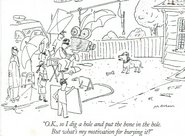
"O.K., so I dig a hole and put the bone in the hole. But what's my motivation for burying it?"
Hollywood in cartoons, 10-21-06 Non-Sequitur by Wiley, www-NON-SEQUITUR.COM

The Magic of Hollywood: A motion has been put forth that we should seek to create rather than imitate. All in favor of killing this silly notion, nod in mindless agreement...
Miami Dolphins

South Beach Hoosier's first Dolphin game at the Orange Bowl came in Dec. 1970, aged 9, a 45-3 win over Buffalo that propelled them into their first ever playoff appearance.
Sebastian the Ibis, the Spirited Mascot of the University of Miami Hurricanes

Before going to my first U-M game at the Orange Bowl in 1972, a friend's father often would bring me home an extra 'Canes game program. That's how I came to have the Alabama at U-M game program from Nov. 16, 1968, which was the first nationally-televised college football night game in color. (A 14-6 loss to the Crimson Tide.) After that first ballgame against Tulane, as l often did for Dolphin games if my father wasn't going, I'd get dropped off at the Levitz parking lot near the 836 & I-95 Cloverleaf in NMB, and catch a Dade County Park & Ride bus, going straight to the Orange Bowl. Onboard, I'd get next to the window and listen to WIOD's pre-game show on my Radio Shack transistor radio. A few times, I was just about the only person onboard besides the bus driver, which was alright by me. Once at the Orange Bowl, if I didn't already have a ticket, I'd buy a game program for myself and one or two for friends or teachers before heading to the ticket window, since you usually couldn't find a program vendor once inside. I probaly had a friend or my father with me for just under 40% of the U-M games I ever went to, but you have to remember that the team, though blessed with several talented players, like Chuck Foreman and Burgess Owens, was just so-so to average at best, and the games were usually played on Friday nights, so it wasn't exactly high on everyone's list of things to do. Depending upon the opponent, if I was alone, I'd often have entire areas of the Orange Bowl to myself. (Wish I had photos of that now!) For instance, I had a good portion of the East (open) End Zone to myself against Oklahoma in the mid-70's, when the Boomer Schooner and the Schooner Crew went out on the field after an Oklahoma TD, and the Schooner received an unsportsmanlike conduct penalty from the refs, as would happen years later in an Orangle Bowl Classic game. (Against FSU?) I was there for the wins and losses under Pete Elliott, Carl Selmer & Lou Saban, and the huge on-field fight in '73 when under eventual national champion Notre Dame (under Ara Parseghian), they called a time-out with less than a minute to go, and already up 37-0. Their rationale? To score another TD and impress the AP football writers; final score 44-0. Well, they got their wish and beat Alabama 24-23 for the title at the Sugar Bowl. A year later, thanks to my Mom's boss, she and I saw Ara's last game as head coach of the Irish in the Orange Bowl Game from the East End Zone -in front of the Alabama cheerleaders!!!- in an exciting 13-11 Notre Dame win over Alabama and Bear Bryant, a rematch of the '73 national title game. I was also present for the U-M's huge 20-15 win under Pete Elliott against Darrel Royal's Texas Longhorns, the week Sports Illustrated's College Football preview issue came out with Texas on the cover, below. I was also present for lots of wins against schools called College of the Pacific, UNLV and Cal-Poly San Luis Obsispo, which I'd then never heard of before.
Miami Dolphins Cheerleaders, April 28, 2007

Photo by Mario J. Bermudez. April 28, 2007 at Dolphins NFL Draft Party at Dolphin HQ, Davie, FL
Of cheerleaders past and present
Given South Florida's unique version of the melting pot -con salsa- demographics and mindset, these women in the photo above are surely what most South Floridians would consider attractive women. But for this observer, who's spent hours & hours at IU cheerleader tryouts and who has known dozens of cheerleaders -and wannabes- in North Miami Beach, Bloomington, Evanston and Washington, D.C., the whole time I was watching these members of the Dolphins' squad perform, I couldn't help but compare them and their routines to those of some IU friends of mine who ALWAYS showed true Hoosier spirit & enthusiasm.
Sitting at my table right near the stage and still later, while watching the long lines of Dolphin fans of all ages waiting to snap photos of themselves with the cheerleaders, I couldn't help but think about those friends who always left me and other Hoosier fans feeling positive & optimistic.
Was there anyone I saw in Davie who possessed these valuable intangibles: the dancing precision of IU Red Stepper -and Captain- Gail Amster, my talented and spirited Phi Beta Kappa pal from Deerfield (IL), who always sat next to me in our Telecom. classes as we took turns entertaining the other; the ebullient spirit & energy of two Hoosier cheerleaders -and captains- from Bloomington, Wendy (Mulholland) Moyle & Sara Cox; the hypnotic, Midwestern, girl-next-door sexiness of Hoosier cheerleader Julie Bymaster, from Brownsburg; or, the adorable Southern girl-next-door appeal of former Hoosier Pom squader Jennifer Grimes, of Louisville, always such a clear distraction while sitting underneath the basket?
Nope, not that I could see. But then they were VERY tough acts to follow!!!
And that's not to mention my talented & spirited friends like Denise Andrews of Portage, Jody Kosanovich of Hammond & Linda Ahlbrand of Chesterton, all of whom were dynamic cheerleaders -and captains- at very large Hoosier high schools that were always in the championship mix, with Denise's team winning the Ind. football championship her senior year when she was captain -just like in a movie. That Denise, Jody & Linda all lived on the same dorm floor, just three stories above me at Briscoe Quad our freshman year, was one of the greatest coincidences -and strokes of luck for me!- that I could've ever hoped for.
You could hardly ask for better ambassadors of IU than THESE very smart, sweet and talented women. In a future SBH post, I'll tell the story of one of the greatest Hoosiers I ever met, the aforementioned Wendy Mulholland, the Bloomington-born captain and emotional heart of the great early '80's IU cheerleading squads, and the daughter of Jack Mulholland, IU's former longtime Treasurer. The acorn doesn't fall far from a tree built on a foundation of integrity & community service!
(After he retired, Mr. Mulholland was the first executive director of the Community Foundation of Bloomington and Monroe County. I used to joke with Wendy that her dad's name was the one that was permanently affixed to the bottom of my work-study checks for years, while I worked at the Dept. of Political Science's Library, first, at the Student Building in the old part of campus, and then later, after it was refurbished, in magnificent Woodburn Hall, my favorite building on campus.)
In that future post, I'll share some reflections on Wendy's great strength of character and personality; my intentions of returning to Bloomington a few weeks before Fall '82 classes started, so I could help Wendy train and work-out to rehab her knee, so she'd feel confident in trying-out for the squad again, following a bad knee injury that'd left her physically-unable to try-out for the squad the previous spring, a big disappointment to those of us who cared about both Wendy and the team; my incredulity at, quite literally, running into Wendy while walking down a sidewalk one afternoon a few years later in Evanston, IL, when we were astonished to discover we were both living there, with me trying to hook on with a Windy City advertising agency, and Wendy then-attending Kellogg (KGSM) at Northwestern, right when the WSJ had named Kellogg the #1 Business School in the country.
I'll also share a story about Wendy performing a true act of kindness towards me in 1982, when I was having a real emergency, and she went above-and-beyond what I had any logical reason to expect. Yet, Wendy, along with her very helpful dad, Jack, came through for me when I was in a very bad time crunch. I've never forgotten Wendy's kindness towards me, and her true Hoosier spirit.
There's NOTHING I wouldn't do for Wendy Mulholland.
It's All About "The U"

South Beach Hoosier's first U-M football game at the Orange Bowl was in 1972, age 11, against Tulane in the infamous "Fifth Down" game. In order to drum up support and attendance for the U-M at the Orange Bowl, that game had a promotion whereby South Florida kids who were school safety patrols could get in for free IF they wore their sash. I did. Clearly they knew that it was better to let kids in for free, knowing their parents would give them money to buy food and souvenirs, perhaps become a fan and want to return for future games. The ballgame made an interesting impression on The New York Times, resulting in this gem from the "View of Sport" column of Oct, 14, 1990, labeled 'Fifth Down or Not, It's Over When It's Over.' -"In 1972, aided by a fifth-down officiating gift in the last moments of the game, Miami of Florida defeated Tulane, 24-21. The country and the world was a much different place that fall because The New York Times took time and space to editorialize on the subject. ''Is it right for sportsmen, particularly young athletes, to be penalized or deprived of the goals for which they earnestly competed because responsible officials make mistakes? The ideal of true sportsmanship would be better served if Miami forfeited last week's game.' South Beach Hoosier hardly needs to tell you that this was YET another New York Times editoral that was completely ignored!
The issue I took with me the night of U-M's 20-15 upset of #1 Texas at the Orange Bowl
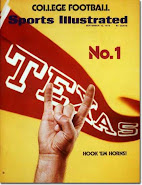
College Football, Texas No. 1, Hook 'em Horns, Sept. 10, 1973. Living in North Miami Beach in the '70's, my Sports Illustrated usually showed up in my mailbox on the Thursday or Friday before the Monday cover date. And was read cover-to-cover by Sunday morning.
The Perfect Storm
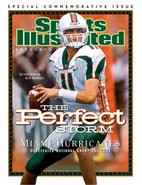
U-M QB Ken Dorsey, Miami Hurricanes Undefeated National Champions 2001, Jan. 2002
Miami's Romp in the Rose
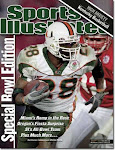
Miami running back Clinton Portis, Jan. 7, 2002
Why the University of Miami should drop football
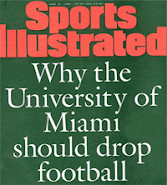
June 12, 1995
REVENGE!
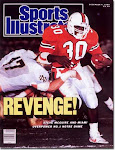
Steve McGuire and Miami Overpower No.1 Notre Dame, Dec. 4, 1989
How Sweet It Is!

Miami Whips Oklahoma For The National Championship, Pictured: Dennis Kelleher, Jan. 11, 1988
My, Oh My, Miami!
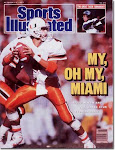
Steve Walsh and the Canes Stun FSU, Oct. 12, 1987
Why Is Miami No. 1?

QB Vinny Testaverde, Nov. 24, 1986
Miracle In Miami
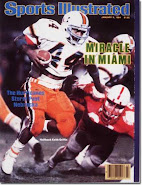
The Hurricanes Storm Past Nebraska, Halfback Keith Griffin, Jan. 9, 1984
Special Issue: College Football
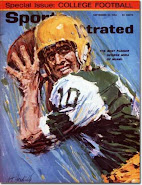
The Best Passer, George Mira of Miami, Sept. 23, 1963
1984 College & Pro Spectatcular
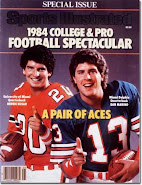
A Pair Of Aces: U-M QB Bernie Kosar & Miami Dolphin QB Dan Marino, Sept. 5, 1984
Pro Football Hall of Fame Special Issue

Dan Marino, Class of 2005, Aug. 2005
FACES OF THE NFL

A Portfolio by Walter Iooss Jr., Ricky Williams, Miami Dolphins, Dec. 9, 2002
Coming Back
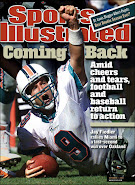
Jay Fiedler rallies Miami to a last-second win over Oakland, Oct. 1, 2001
Dan's Last Stand
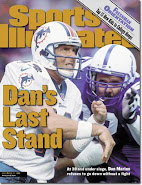
At 38 and under siege, Dan Marino refuses to go down without a fight, Dec. 13, 1999
The War Zone

In the NFL's toughest division, the surprising Dolphins are on top, Lamar Smith, Dec. 11, 2000
Down and Dirty
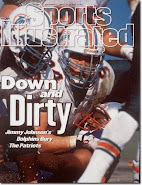
Jimmy Johnson's Dolphins Bury The Patriots, Steve Emtman, Sept. 9, 1996
The Sunshine Boys

Now Playing in Miami: The Dan Marino and Jimmy Johnson Show, May 11, 1996
HOT & NOT

Miami loves Pat Riley but wants to give Don Shula the boot, Dec. 11, 1995
NFL PREVIEW 1995

Which of today's stars are locks for the Hall of Fame? Dan Marino for sure. But who else? To find out, we polled the men who do the voting. Sept. 14, 1995
Sportsman Of The Year

Don Shula, Dec. 20, 1993
Dan The Man

Dan Marino Saves The Day For The Dolphins, Jan. 14, 1991
Dangerous Dan
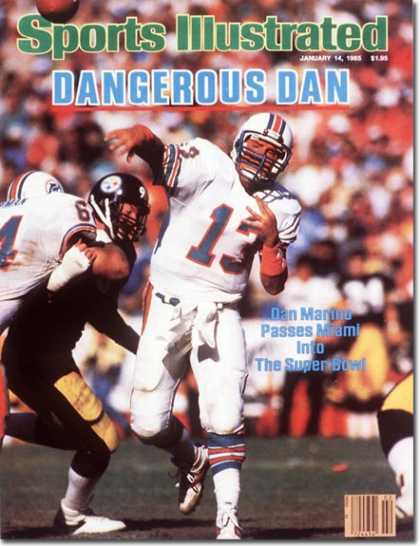
Dan Marino Passes Miami Into The Super Bowl, Jan. 14, 1985
Super Duper!

Wide Receiver Mark Duper Of The Undefeated Dolphins, Nov. 19, 1984
Air Raid! Miami Bombs Washington
+Sep+10,+1984.jpg)
Mark Clayton (burning Darryl Green) Sept. 10, 1984
Rookies On The Rise
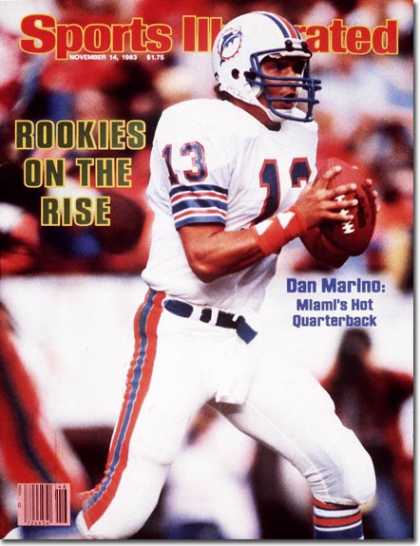
Dan Marino: Miami's Hot Quarterback, Nov. 14, 1983
New Life In The WFL
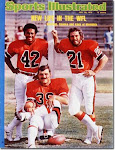
Warfield, Csonka and Kiick of Memphis, July 28, 1975
Zonk! Miami Massacres Minnesota
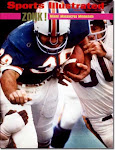
Larry Csonka, Jan. 21, 1974
Pro Football, Miami Is Rough And Ready

Larry Csonka & Bob Griese, Sept. 17, 1973
Miami All The Way

Bob Griese, Jan. 22, 1973
It's Miami and Washington
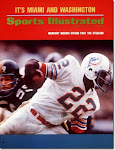
Mercury Morris Speeds Past The Steelers, Jan. 8, 1973
Kiick and Csonka, Miami's Dynamic Duo

Larry Csonka & Jim Kiick, Aug. 7, 1972
Sudden Death at Kansas City
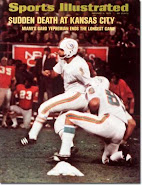
Miami's Garo Yepremian Ends the Longest Game; (kneeling) placekick holder Karl Noonan, Jan. 3, 1972
New Pro in a New Town

Miami's Frank Emanuel, Aug. 8, 1966
Old-style "Obie" the Orange Bowl Committee mascot

The iconic image I grew-up with in Miami, before FedEx got into the picture

